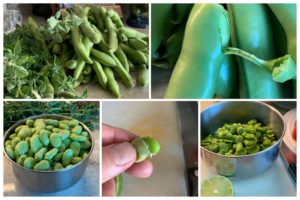Pasta with Fava Beans

Early last winter, well before the lockdown, I planted a few rows of a heritage variety of fava beans for a cover crop. I cut back several plants at flowering to force nitrogen into the soil. The rest I reserved for eating and seed.
A single plant produces a lot of beans. Like zucchini, you have to think of innovative uses for the beans to keep up with their production. One of these is this simple recipe for pasta with favas. It is similar to our recipe for pasta with peas but adds a bay leaf for a savory element.
Ingredients
- 1 lb fava beans, shelled and peeled
- 3 cloves garlic, smashed and finely chopped
- ½ cup Pecorino Romano cheese, grated
- 1 bay leaf
- ¼ cup of olive oil
- 1 lb linguine or pappardelle pasta
Directions
Shell the fava beans (remove the string and run your finger along the side to open – see photo). Place the beans into lightly salted boiling water and boil for 5 minutes. Drain the beans, reserving the water, and put them into ice water bath to stop the cooking. Using your fingers, remove the waxy peal.
Bring the reserved water to a boil and add your pasta. Cook according to package instructions.
While the pasta is cooking, gently simmer the garlic and bay leaf in a large pan. Do not let the garlic burn. Remove the pasta about 2 minutes before it is done and add to the pan with the garlic and oil and toss. Add some of the pasta water to the pan and continue to cook the pasta. Just as the pasta is finishing add the cheese and continue to toss.
Remove the bay leaf and serve.
How to shell and peel fava beans
The first trick is removing the beans from the shell. To expedite this, find the string at the stem end and peel it back. Then it is a simple matter to run your finger along the shell and open it up. The beans will fall out.
The second trick its to remove the waxy cover. Put the beans into boiling salted water and cook for five minutes. Remove from the water and transfer the beans to an ice bath to stop cooking.
Holding the bean by an end (see photo), slip the waxy cover off. You may have to use your finger nail to open the waxy cover to facilitate the removal.
This is a lot of hard work, but worth the effort – especially if you treat yourself to a glass of your favorite wine. We particularly like our new Malvasia Bianca with this wine, but our rosé and chardonnay are also delightful. Enjoy!



